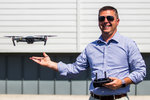
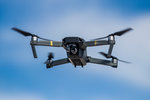
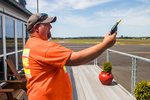
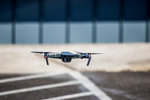
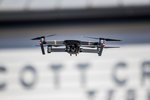

When rogue seagulls land at the Chehalis-Centralia Airport, it’s up to the airport’s staff to make sure the birds stay away from the runway.
“One thing that is very important is that aircraft don’t strike birds,” said airport operations coordinator Brandon Rakes. “If a jet were to inhale a seagull, it would be a bad day for everybody.”
Rakes referenced Chesley “Sully” Sullenberger, who crash-landed a commercial jet in the Hudson River after striking a flock of geese in 2009.
“We don’t want nothing [crash-landing] in the Chehalis,” joked airport maintenance staffer Austin Barnes.
Currently, Barnes and his team use firearms to scare away the birds, shooting off explosive rounds that burst overhead with a loud bang. Soon, they’ll be switching to a drone, flying the airport’s new DJI Mavic Pro quadcopter out to “haze” any animals that wander onto the airport.
“This gives us a cleaner, safer, more effective way to deal with those,” Rakes said.
Using a drone poses less danger than firing projectiles, and it’s also less likely to leave debris on the runway. Additionally, it makes less noise, making it a more “community-friendly” option in light of the many nearby businesses.
“That thing’s a lot quieter than a bird-banger [gun],” Barnes said.
Barnes said scaring off birds can be time-consuming, especially in the winter, when wet weather seems to bring them to the airport on a regular basis.
Rakes first learned about the drone option at an industry conference last year. After spending some time researching, he opted to purchase the drone two weeks ago. The $900 model has a range of four miles, though Rakes said he’s legally required to operate it within line of sight.
Currently, Rakes is the only airport staffer licensed to operate the drone, though other airport employees will be completing the necessary training soon. Though he has yet to send the drone after any birds, Rakes is excited to implement his newest piece of equipment.
“This isn’t a toy,” he said. “This is an actual tool.”
The drone is equipped with a 4K resolution camera, GPS sensors to return it to its takeoff point if it loses reception and obstacle avoidance technology. It also uses geo-fencing to keep it away from pre-mapped areas that might pose a danger to aircraft. Its battery allows it to fly for about 27 minutes.
Scaring seagulls may not be the only task Rakes finds for the drone. He said it could prove useful for hangar inspections, documenting repairs on airport projects and providing imagery for airport property Chehalis is attempting to market.
“We’re still coming up with uses for it,” he said.